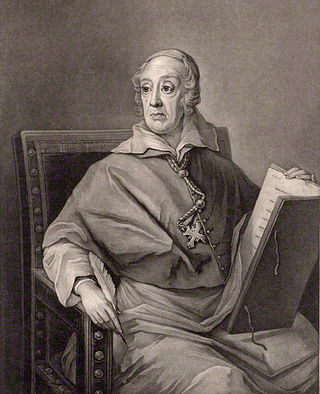
Nicholas Patrick Stephen Wiseman was an English Catholic prelate who served as the first Archbishop of Westminster upon the re-establishment of the Catholic hierarchy in England and Wales in 1850. He was made a cardinal in 1850.

Frederick Oakeley was an English Roman Catholic convert, priest, and author. He was ordained in the Church of England in 1828 and in 1845 converted to the Church of Rome, becoming Canon of the Westminster Diocese in 1852. He is best known for his translation of the Christmas carol Adeste Fideles from Latin into English.
Henry Weedall was a British nineteenth century Roman Catholic preacher, educator and churchman.

The Archdiocese of Birmingham is one of the principal Latin Church diocese of the Catholic Church in England and Wales. The archdiocese covers an area of 3,373 square miles (8,740 km2), encompassing Staffordshire, the West Midlands, Warwickshire, Worcestershire and much of Oxfordshire as well as Caversham in Berkshire. The metropolitan see is in the City of Birmingham at the Metropolitan Cathedral Church of Saint Chad. The metropolitan province includes the suffragan dioceses of Clifton and Shrewsbury.

St Mary's College in New Oscott, Birmingham, sometimes called Oscott College, is the Roman Catholic seminary of the Archdiocese of Birmingham in England and one of the three seminaries of the Catholic Church in England and Wales.

Walston was an Anglo-Saxon prince, known for the miracles which occurred during and after his life after he became a farm worker. He is a patron saint of farm animals and agricultural workers, who once visited his shrine at the church at Bawburgh, in the English county of Norfolk. Two sources for his life exist: the De Sancto Walstano Confessore in the Nova Legenda Angliæ, printed by Wynkyn de Worde in 1516, and known as the English Life; and a later Latin manuscript copied in 1658 from a now lost medieval triptych, now in the Lambeth Palace library in London.

Aubrey George Spencer was the first bishop of the Anglican Diocese of Newfoundland and Bermuda (1839–1843). He was also bishop of Jamaica. His brother George Spencer became Bishop of Madras. He is from the Spencer family.

Bonaventure Giffard (1642–1734) was an English Catholic prelate who served as the Vicar Apostolic of the Midland District of England from 1687 to 1703 and Vicar Apostolic of the London District from 1703 to 1734.
William Eusebius Andrews was an English journalist and editor who created a number of Catholic newspapers.
Francis Kerril Amherst T.O.S.D., was an English Bishop of the Roman Catholic Diocese of Northampton in England.
William Poynter was an English Catholic priest who served as Vicar Apostolic of London.

Bishop William Wareing was the first Roman Catholic Bishop of the Diocese of Northampton.
Thomas Walsh was an English Catholic prelate who served as Vicar Apostolic of the London District from 1848 until his death.
William Henry Anderdon was an English Jesuit and Catholic writer, born in London.
John Milner was an English Roman Catholic bishop and controversialist who served as the Vicar Apostolic of the Midland District from 1803 to 1826.
John Joseph Hornyold was an English Catholic bishop, titular Bishop of Phiomelia, and Vicar Apostolic of the Midland District, England for twenty-two years.
James Spencer Northcote was an English Catholic priest and writer. He served as president of St Mary's College, Oscott for seventeen years.
Charles Berington was an English Roman Catholic bishop who served as the Vicar Apostolic of the Midland District from 1795 to 1798.
William Errington was an English Roman Catholic priest, and founder of Sedgley Park School.
Gregory Stapleton D.D. was an English Roman Catholic bishop. While president of St. Omer's English College, he and his students were imprisoned during the French Revolution.








